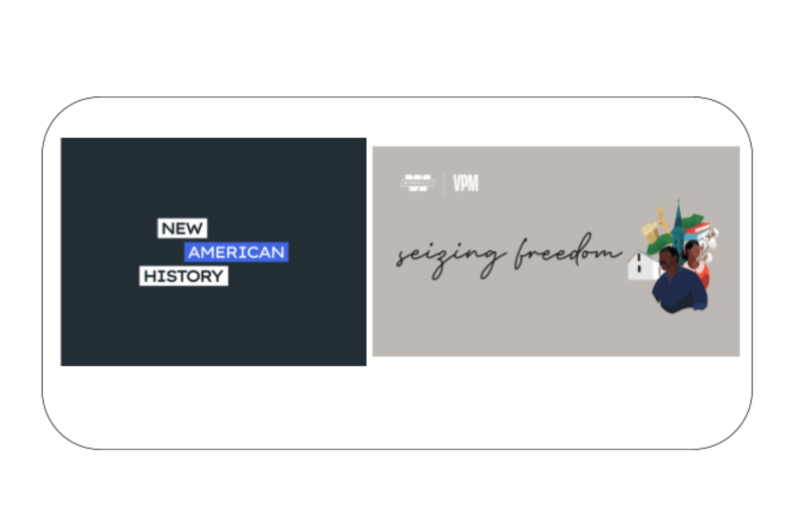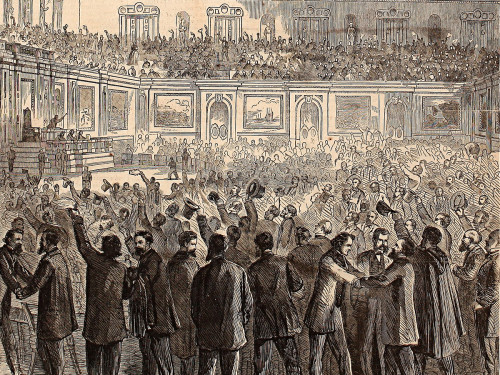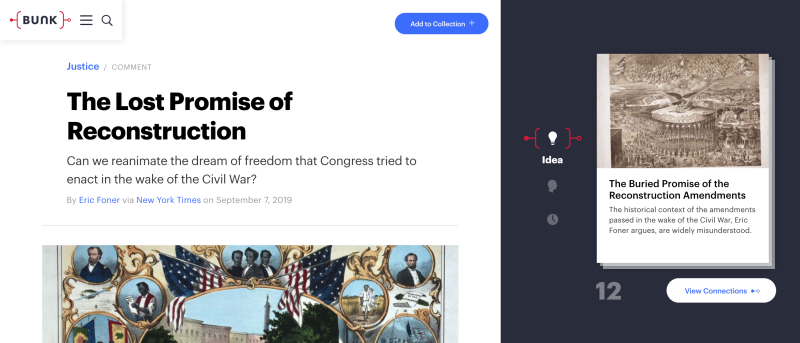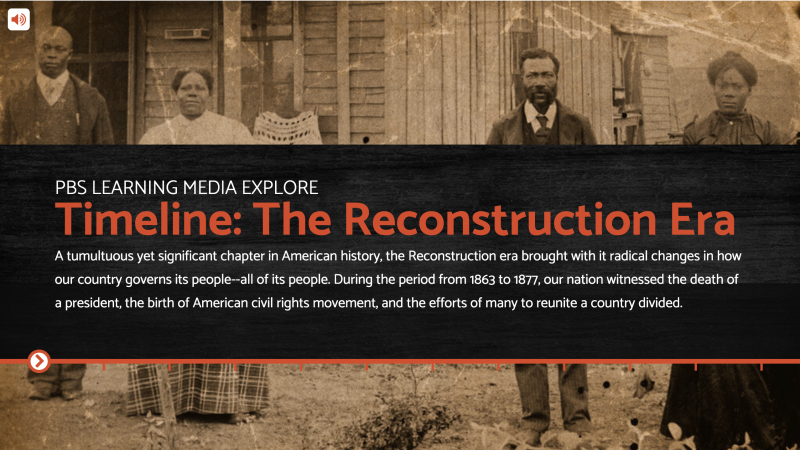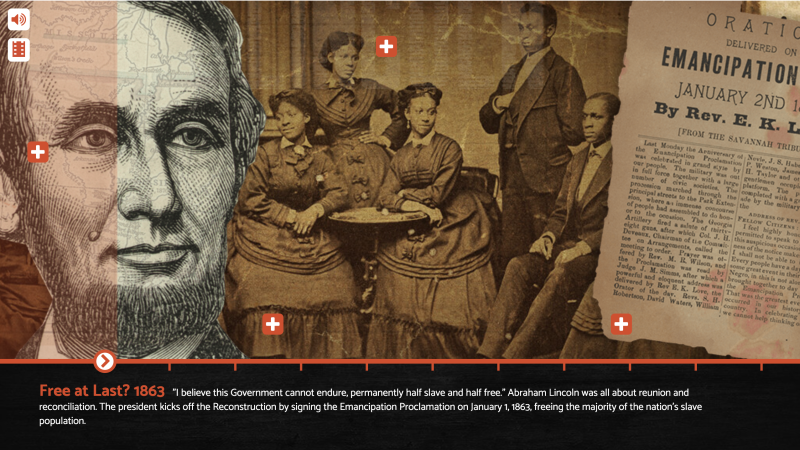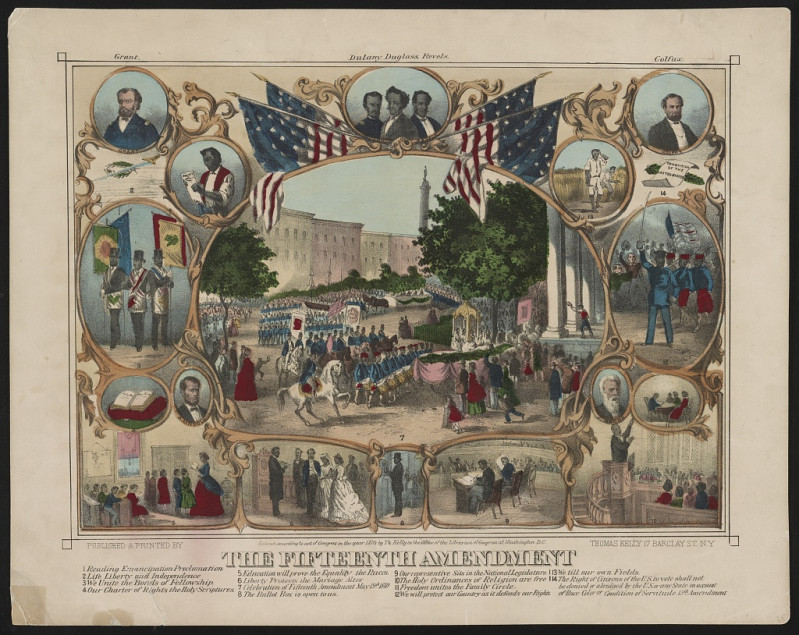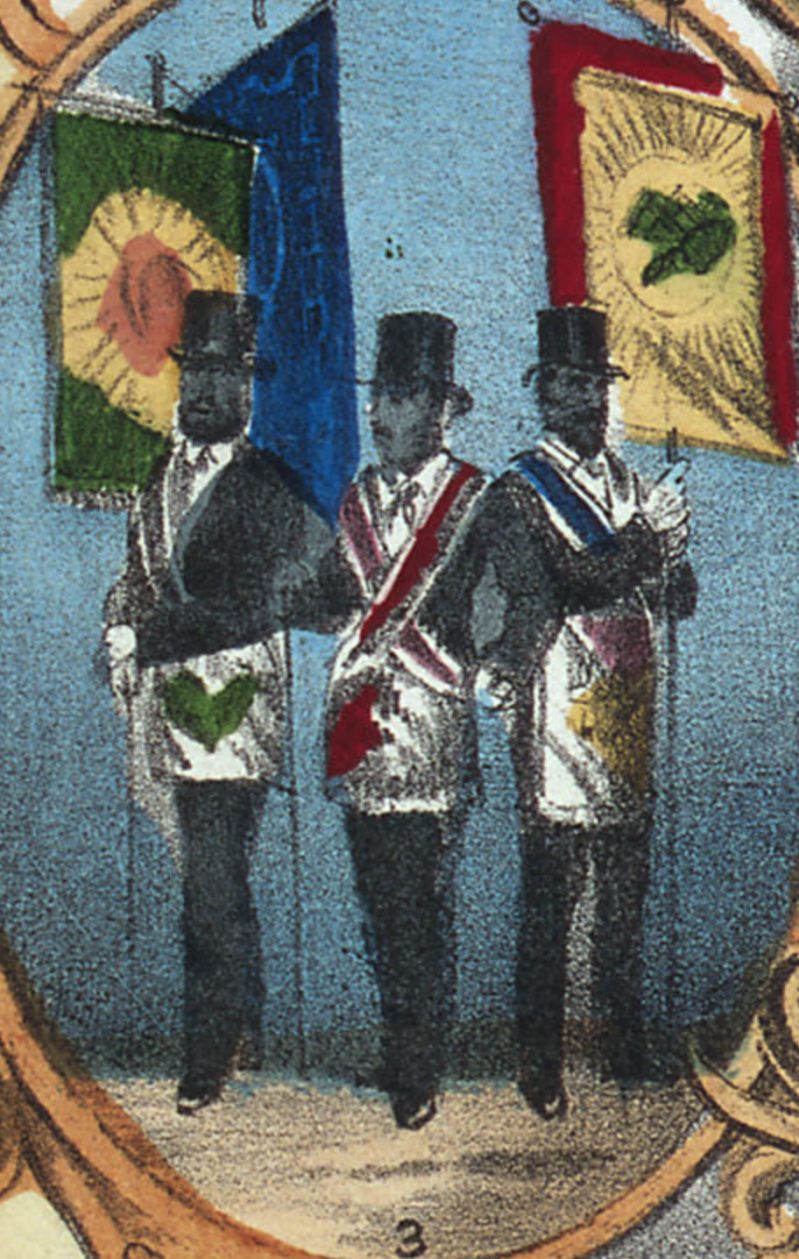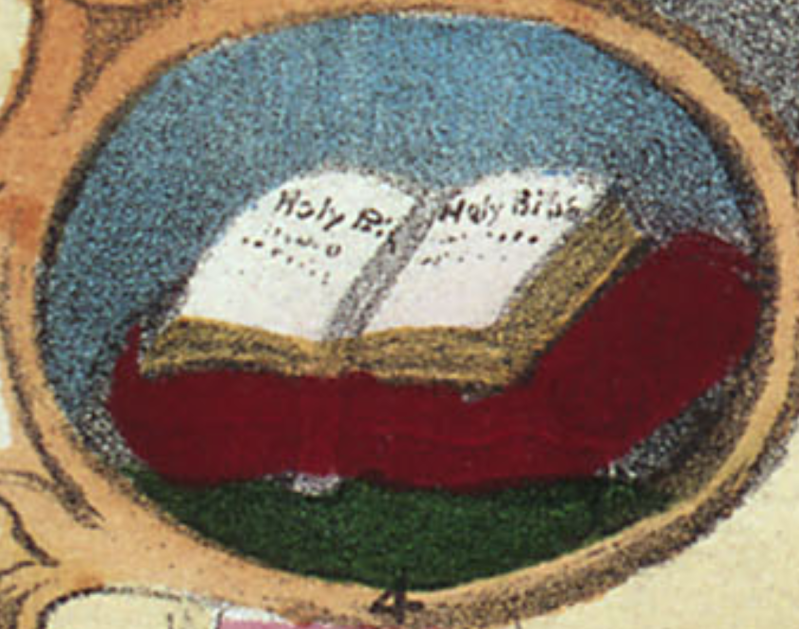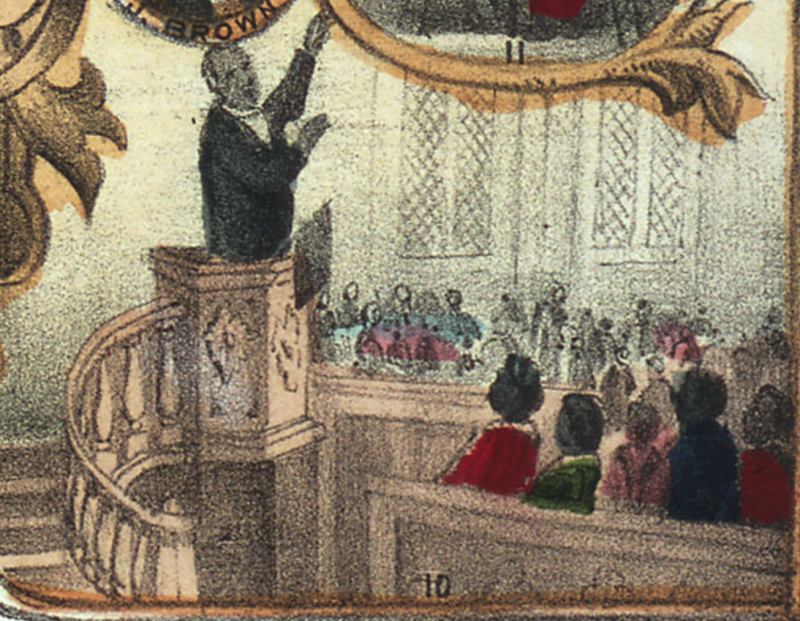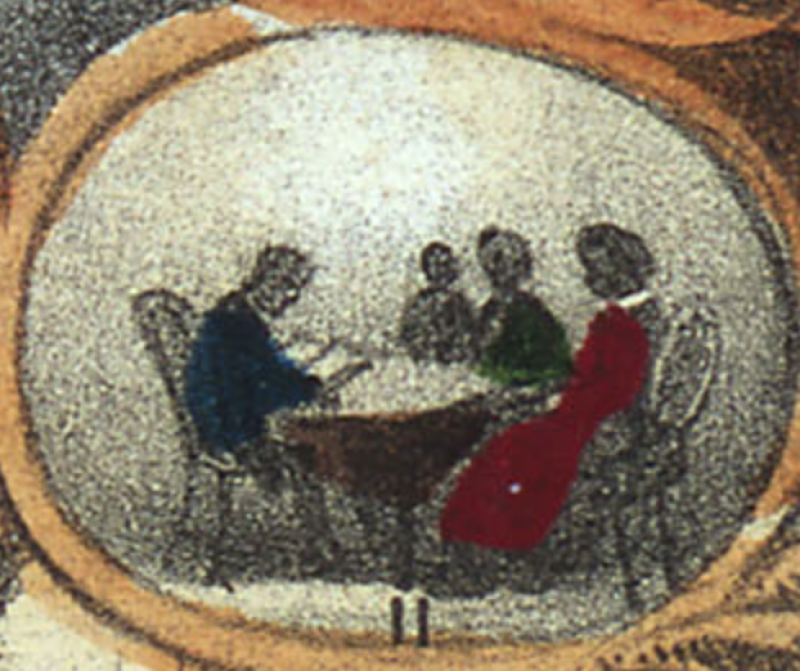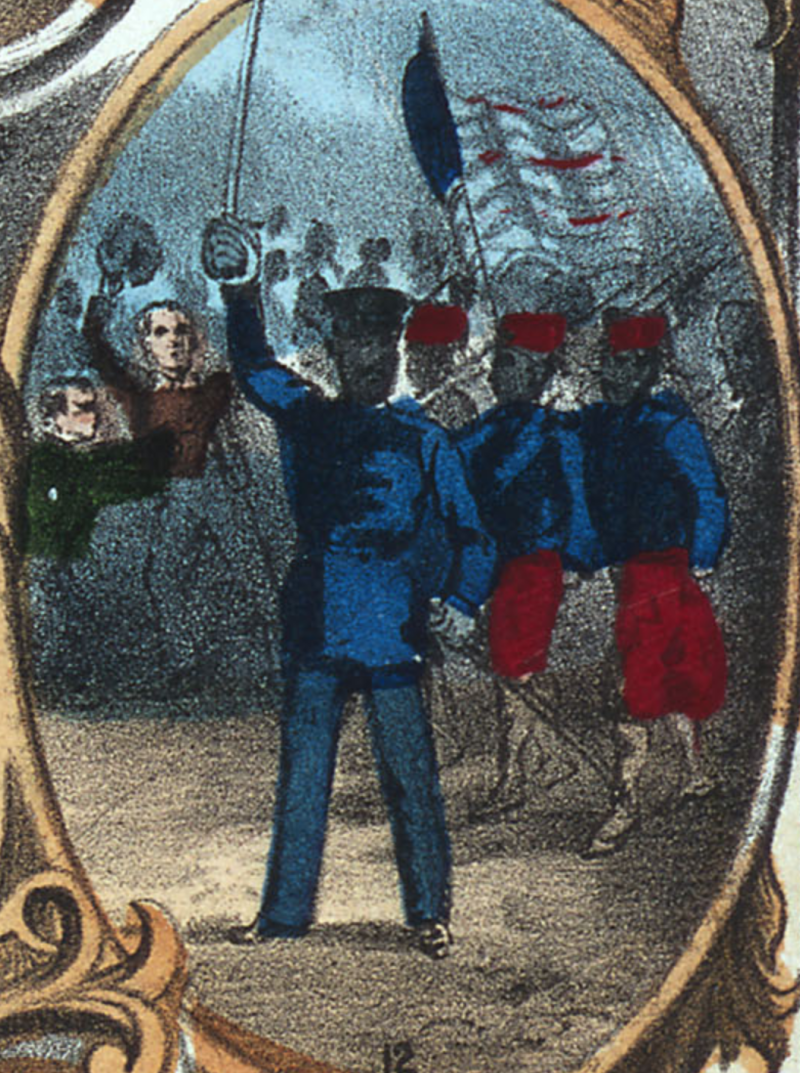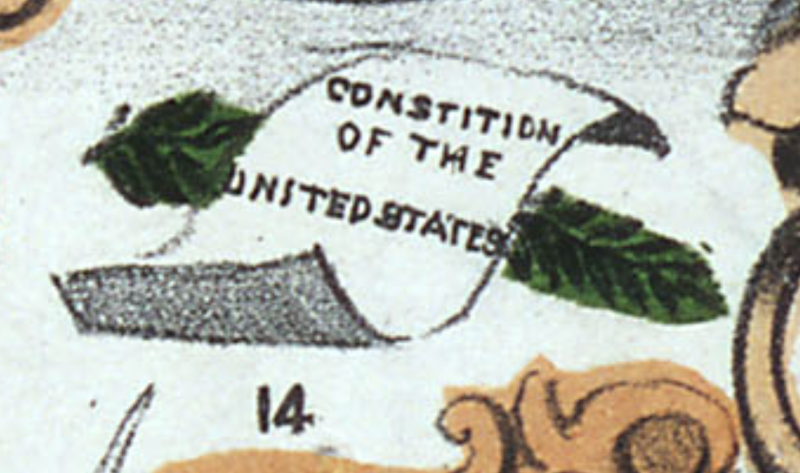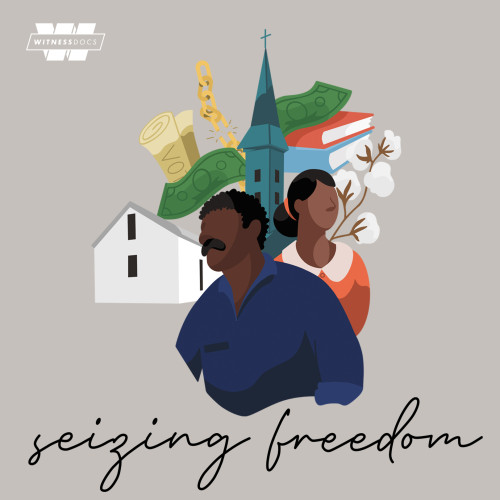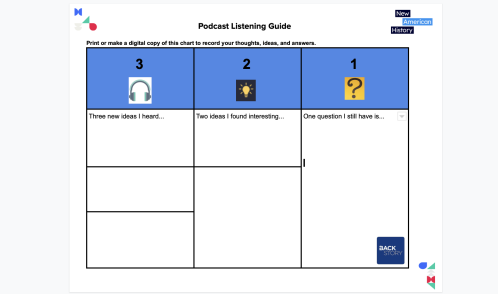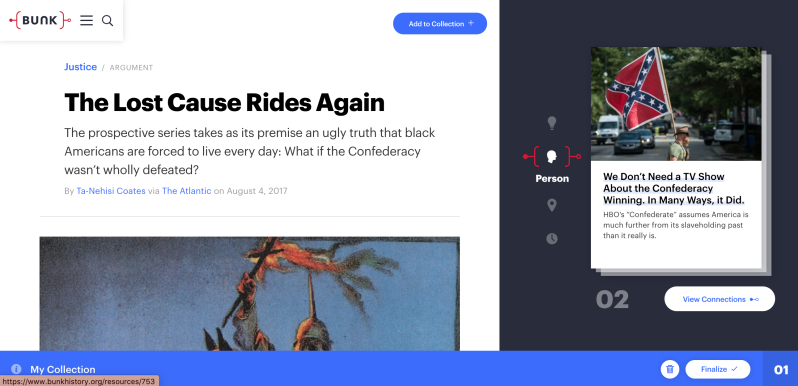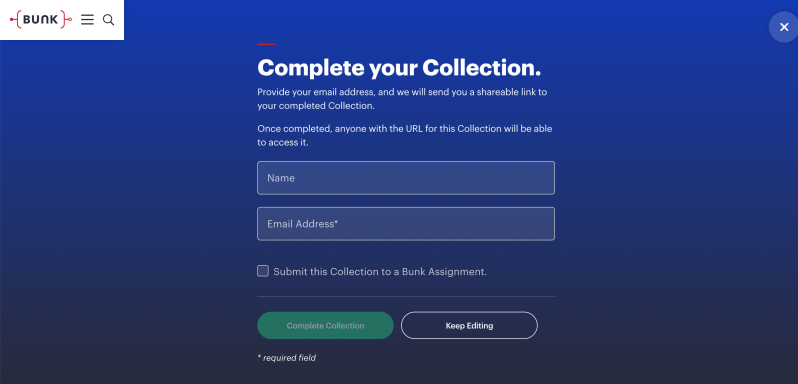This work by New American History is licensed under a Attribution-NonCommercial-ShareAlike 4.0 (CC BY-NC-SA 4.0) International License. Permissions beyond the scope of this license may be available at newamericanhistory.org.
Seizing Freedom: Reconstruction - An Unfinished Revolution
View Student Version
Standards
Teacher Tip: Think about what students should be able to KNOW, UNDERSTAND, and DO at the conclusion of this learning experience. A brief exit pass or other formative assessment may be used to assess student understandings. Setting specific learning targets for the appropriate grade level and content area will increase student success.
Suggested Grade Levels: High School (9-12)
Suggested Timeframe: 2-3 90 minute class blocks
Suggested Materials: Internet access via laptop, tablet, or mobile device
Key Vocabulary
Amendment - to officially change a document, law, or policy, such as a Constitutional amendment
Barriers - policies, laws, actions, objects meant to stop a person or group of people from moving forward
Ku Klux Klan (KKK) - a white supremacist group founded in 1865 to intimidate African Americans and other minority groups from asserting themselves in any way, including politically
Legacy - money, property, ideas or values handed down from generation to generation
Lost Cause - the belief that slavery was a fair, moral system, and that the Southern states’ reasons for forming the Confederacy were honorable
Portrait - an image of a person, usually a painting
Reconstruction - the period after the Civil War, from about 1863-1877, when the federal government passed civil rights legislation and attempted to transform the Southern states as they returned to the Union
Representative Democracy - a form of democracy in which the people elect someone to the government who will speak up for them and vote for laws that benefit them
Seizing - taking something by force
Socialite - a wealthy person who spends most of their time attending social gatherings and influencing people in power (like a social media influencer today)
Vignette - a small illustration that is part of a larger image or narrative
Read for Understanding
Teacher Tips:
This Learning Resource includes language in the body of the text to help adapt to a variety of educational settings, including remote learning environments, face-to-face instruction, and blended learning. If you are teaching remotely, consider using videoconferencing to provide opportunities for students to work in partners or small groups. Digital tools such as as Google Docs or Google Slides may also be used for collaboration. Rewordify helps make a complex text more accessible for those reading at a lower Lexile level while still providing a greater depth of knowledge.
In this Learning Resource, students will also be exploring connections and working to build a collection in Bunk. For more information about connections, assignments, or collections in Bunk, visit bunkhistory.org. They will also create a presentation which may be designed using Google Slides, PowerPoint, Prezi, Easelly, Powtoon, Animoto, iMovie, Haiku Deck, VoiceThread, or Kizoa.
This Learning Resource was developed in collaboration with VPM/Witness Docs from Stitcher, co-producers of the Seizing Freedom podcast. It utilizes two different instructional strategies: Analyzing Images as described by Facing History and Ourselves and Chalk Talk as explained by BetterLesson. Analyzing Images is meant to guide students through a close analysis of an image as they develop an awareness of historical context, practice critical thinking skills, enhance their observation and interpretive skills, and develop conceptual learning techniques. In a chalk talk silent discussion, students "talk" with each other through writing about a prompt, problem, or question. This strategy is a great way to promote discussion, encourage participation, and provide students with the chance to think in silence before responding aloud to a classmate.
Use the Chalk Talk strategy to let students generate as many examples as they can. Using this strategy, students “talk” with each other using their pen/marker on paper to respond to the prompt. For this activity, student groups should use the same large piece of paper to respond to all parts of the prompt.
- If you are teaching this lesson virtually, choose a digital collaboration tool with which your students are already familiar, like Google Slides, Padlet, or the whiteboard feature in video conferencing platforms.
- Help them make the connections between the progress being made by Black Americans and the reactions by White Americans to impede that progress (i.e.: Black Codes, the rise of the Ku Klux Klan, landmark Supreme Court decisions United States v. Cruikshank, or Plessy v. Ferguson.)
- Where appropriate, draw lines to visually connect these ideas
- Identify and correct any student misconceptions
- Include the names of individuals on the side of progress (i.e.: Thaddeus Stephens) or obstruction (i.e.: Andrew Johnson).
These Learning Resources follow a variation of the 5Es instructional model, and each section may be taught as a separate learning experience, or as part of a sequence of learning experiences. We provide each of our Learning Resources in multiple formats, including web-based and as an editable Google Doc for educators to teach and adapt selected learning experiences as they best suit the needs of your students and local curriculum. You may also wish to embed or remix them into a playlist for students working remotely or independently.
For Students:
After the Civil War – a period historians call “reconstruction” – political and societal change was massive and unprecedented. The end of slavery brought challenges alongside hope. This lesson looks at some of the changes, including: what freedom actually meant, the promises lost, and the legacy of this tumultuous period.
Engage:
Who is allowed to represent the American people in our representative democracy?
Examine this image closely.
- What do you notice?
Look at the people.
- What are they wearing?
- How are they presenting themselves?
- What words come to mind as you look at them?
Look at the words.
- What do they tell you about this image?
- What surprises you about this image? What confirms what you already knew?
- What are you curious about? What questions do you have?
- How might you find out more?
Your teacher may ask you to record your answers on an exit ticket.
Explore:
In what ways did Reconstruction change the lives of Black Americans after the Civil War?
Listen to the BackStory podcast episode: How Reconstruction Transformed the Constitution.
As you listen, use the Guide to Reconstruction Notes to identify how the 13th, 14th, and 15th amendments sought to define freedom, citizenship, and equality under the law.
After the podcast finishes, navigate to Bunk History to explore how the lives of Black Americans changed after the Civil War. Scroll through the articles and select a title that stands out or seems interesting to you. There are over 200 Reconstruction articles to choose from!
You do not need to read every article. Just select one to start, and explore the connections from there.
When you open an article, you will notice the stack of cards to the right of the excerpt. There are also icons that may include a light bulb, map pin, or clock next to the article that symbolize different types of connections you can make using Bunkhistory.org to learn more about history and current events. Take a few minutes to explore the cards and icons. You will notice that each icon leads you to a new stack of cards. To learn more about these, read How Connections Work.
Use the Reconstruction Progress and Barriers Notes to organize your thinking as you explore beyond the three Reconstruction amendments.
Next, explore this interactive timeline from the PBS series Reconstruction: America After the Civil War and add to your Reconstruction Progress and Barriers notes.
The timeline is narrated and can be navigated using the slider tool along the bottom. Each event along the timeline includes “+” buttons within the image that can be expanded to provide additional context.
Think about what barriers were put up in response to each indicator of progress made by Black Americans after the Civil War.
Your teacher may ask you to record your answers on an exit ticket.
Explain:
How did the United States deal with the end of human enslavement?
This 1870 Thomas Kelly print shows a parade surrounded by portraits and vignettes of Black life, illustrating rights granted by the 15th amendment.
Spend some looking closely at this image using the Facing History Analyzing Images strategy. Click the blue arrows in the image gallery to see close-up images of the illustrations in each vignette.
- Step One: Look deeply at the picture for a good long time. Notice shapes, colors, textures, the position of people and/or objects, etc.
- Step Two: Write down what you see without making any interpretation about what the picture is trying to say.
- Step Three: What questions do you have about this picture that you would need to have answered before you can begin to interpret it? Ask as many questions as you have.
- Step Four: Discuss your questions with two other students in the class to try to find some answers.
- Step Five: Given the historical context and subject of the piece, what do you think the artist is trying to say (what does the piece mean), and who do you think is the intended audience?
- Step Six: Discuss your interpretation with the class, and be prepared to support your view by referring to specific elements of the image and what you know about the history of the time.
After analyzing the image, share what you discovered about Reconstruction, especially related to progress and barriers. Your teacher will provide directions for a Chalk Talk activity.
Your teacher may ask you to record your answers on an exit ticket.
Elaborate:
What does it mean to be free in the United States?
Seizing Freedom is a new podcast about the Reconstruction era—this is a preview of the first episode, available in the fall of 2020. Listen to the podcast, then reflect on what Freedom means to you now. Your teacher may ask you to use this podcast listening guide to help you organize your thoughts and ideas as you listen.
Craft a shared definition of what freedom means in this country. Consider the government’s responsibility to treat people equally under the law (14th amendment).
Using this definition, you will create a presentation that includes at least 5 specific examples of what freedom means and looks like in our everyday lives. You may work with a partner, and if working remotely use a collaborative presentation platform such as Google Slides, Powerpoint, or any presentation platform your teacher permits.
- For example: Freedom means that, if I choose, I can marry whomever I want.
Along with each example, include which people are currently included in this definition of freedom and which, if any, are left out.
- For example: In the U.S. today, any two consenting adults can get married. However, this freedom has only been recently expanded. Until 1967, some states still prevented interracial marriage (Loving v. Virginia) and same-sex marriage was illegal in most states until 2015 (Obergefell v. Hodges). Even today, marriage is limited to only 2 adults.
Your teacher may ask you to record your answers on an exit ticket.
Extend:
What is the legacy of Reconstruction?
Take a look at this video resource on Bunk, How Southern Socialites Rewrote Civil War History, about the prevalence of the Lost Cause philosophy in our historical narrative. Think about what you have already learned about Reconstruction as you view and explore some of the connections, tags and ideas presented in Bunk.
Reflect on these questions:
- What did you learn about Reconstruction?
- What were some successes of Reconstruction?
- What barriers were put into place to stop the advances made by people of color during Reconstruction?
- What connections can you make between Reconstruction and the United States today?
- What lessons can we learn today from the Reconstruction era?
- How can teachers, students, and others take back the narrative to tell a more complete history of Reconstruction?
Create a Bunk collection of 3- 5 articles that help reframe the Reconstruction narrative.
Get started by browsing Bunk. When you find a thought-provoking Excerpt or Original, click the Add to Collection + button. Include a note describing the significance of the piece to your Collection. (Notes are shown when readers view a particular Excerpt or Original from your Collection.)
Annotate each article you add to your collection by explaining why you chose it and how it can help teachers, students, or others take back the narrative and tell a more complete history of Reconstruction.
While continuing your search, add more content to your Collection by clicking the Add to Collection + button on other Excerpts or Bunk Originals. Keep in mind: Collections are stored in your browser using cookies until they’re completed, so if you exit your browsing session or clear your cookies before completing, your Collection may be lost.
Once you’ve finished building your Collection, finalize your Collection by giving it a name and an optional description, and then click the Complete Collection button. Your teacher will explain how to share your collection with them.
Your teacher may ask you to record your answers on an exit ticket.
Citations:
"Analyzing Images." Facing History and Ourselves. Accessed July 29, 2020. https://www.facinghistory.org/resource-library/teaching-strategies/analyzing-images.
Bunk History. New American History. Accessed July 29, 2020. https://www.bunkhistory.org/tags/ideas/111.
"Colored People's Convention of South Carolina, Address of the Colored State Convention to the People of the State of South Carolina, November 24, 1865, Charleston, South Carolina," House Divided: The Civil War Research Engine at Dickinson College, http://hd.housedivided.dickinson.edu/node/44782.
Currier & Ives. The first colored senator and representatives - in the 41st and 42nd Congress of the United States. 1872. Illustration. Accessed July 29, 2020. https://www.loc.gov/pictures/item/98501907/.
Kelly, Thomas. The Fifteenth amendment. 1870. Illustration Accessed July 29, 2020. https://lccn.loc.gov/93510386.
Lowndes, Coleman. “How Southern Socialites Rewrote Civil War History,” October 25, 2017. https://www.bunkhistory.org/resources/1246.
Matos, Juan. "Chalk Talk or Silent Discussion." BetterLesson. Accessed July 29, 2020. https://betterlesson.com/strategy/326/chalk-talk-or-silent-discussion.
PBS Learning Media, ed. "Timeline: The Reconstruction Era." Reconstruction: America after the Civil War. Accessed July 29, 2020. https://www.pbs.org/weta/reconstruction/timeline/.
“VA Foundation for the Humanities | How Reconstruction Transformed the Constitution” BackStory. Virginia Humanities, October 11, 2019. https://www.backstoryradio.org/shows/how-reconstruction-transformed-the-constitution.
Wikimedia Commons contributors, "File:15th-amendment-celebration-1870.jpg," Wikimedia Commons, the free media repository, https://commons.wikimedia.org/w/index.php?title=File:15th-amendment-celebration-1870.jpg&oldid=393527727 (accessed July 29, 2020).
View this Learning Resource as a Google Doc


